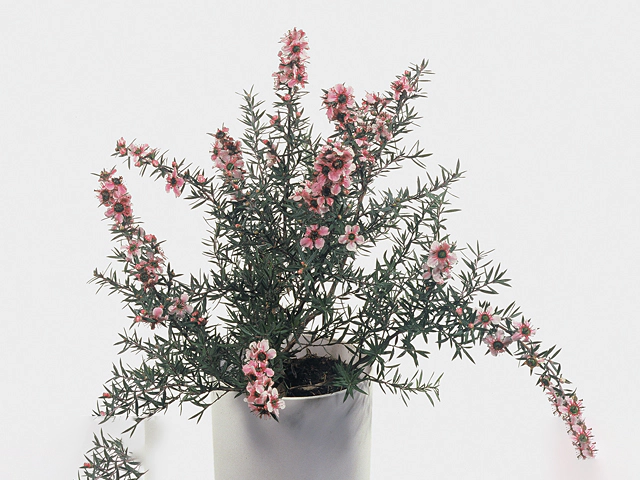Leptospermum scoparium

| Flower scent | Normal; Unscented |
| Winter hardness | Limited (USDA-zone 8) |
| Flower color | White; White-white-155B; Pink-medium red pink-052B |
| Leaf, general shape | Lanceolate; Elongate |
| Plant height | 2 - 2,5 m; 2,5 - 3 m; 4 - 5 m; 5 - 6 m |
| Flower color distribution | Bicolored |
| Flower, secondary color(s) | Pink |
| Toxicity (if consumed) | Not or barely |
The Tea Tree, also known as Leptospermum scoparium, is a versatile and beautiful plant with a wide range of characteristics. It is commonly found in New Zealand and Australia, where it has been used for centuries for its medicinal properties. In recent years, its popularity has spread worldwide due to its unique fragrance and potential health benefits.
One of the distinguishing features of the Tea Tree is its flower scent. While some varieties are unscented, others have a pleasant aroma reminiscent of honey or herbs. This scent has made it a popular ingredient in perfumes, candles, and essential oils.
When it comes to winter hardiness, the Tea Tree has its limitations. It thrives best in USDA zone 8, which means it can withstand cooler temperatures but may struggle in more frigid climates. However, with proper protection and care, it can still grow successfully in colder regions.
The Tea Tree's flowers come in a variety of colors, including white, white-white, and pink-medium red pink. These delicate blooms are bi-colored, with secondary colors ranging from a soft pink hue. They attract pollinators such as bees and butterflies, making them a welcome addition to any garden.
The leaves of the Tea Tree are lanceolate and elongated, adding to its overall elegance. They are small and compact, giving the plant a dense and bushy appearance. Depending on the specific variety, the Tea Tree can reach heights ranging from 2 to 6 meters, making it suitable for both small gardens and larger landscapes.
One important consideration when it comes to the Tea Tree is its toxicity. While it is not or barely toxic if consumed, caution must still be exercised, especially in households with pets or small children. It is always advisable to keep any potentially harmful plants out of reach to avoid any accidents.
In addition to its aesthetic appeal, the Tea Tree has been revered for its medicinal properties. It is believed to have antimicrobial, antifungal, and anti-inflammatory properties, making it useful in treating various conditions. Tea Tree oil, extracted from the leaves, is commonly used topically to help heal wounds, treat acne, and soothe skin irritations.
Overall, the Tea Tree, with its beautiful flowers, unique fragrance, and potential health benefits, is a remarkable plant that deserves a place in any garden. Its ability to adapt to different climates and its versatility in various applications make it an attractive choice for both budding gardeners and experienced horticulturists.
Market availability index by month:
| Jan. | Feb. | Mar. | Apr. | May | Jun. | Jul. | Aug. | Sep. | Oct. | Nov. | Dec. |
|---|---|---|---|---|---|---|---|---|---|---|---|
| 2 | 1 | 4 | 3 | 3 | - | - | 3 | - | 2 | 3 | 3 |